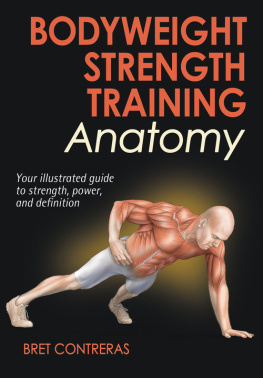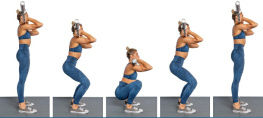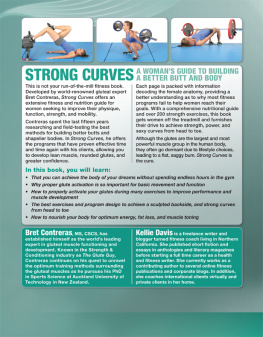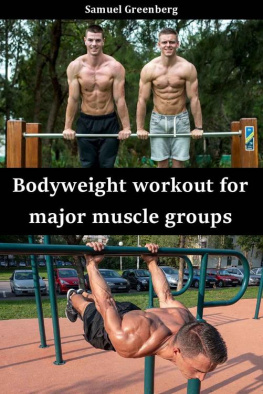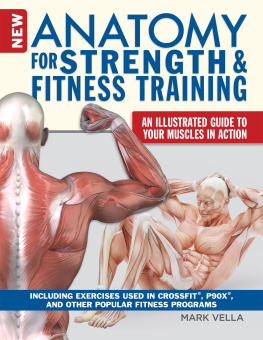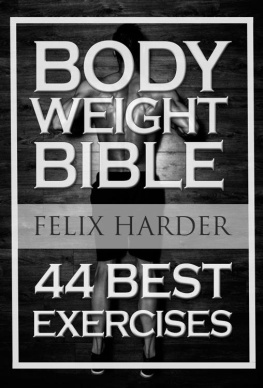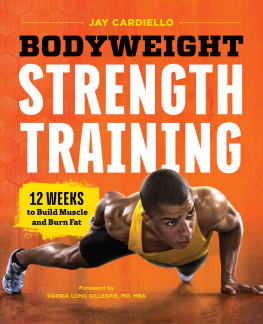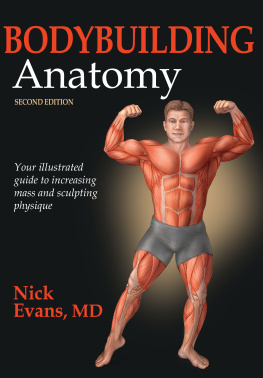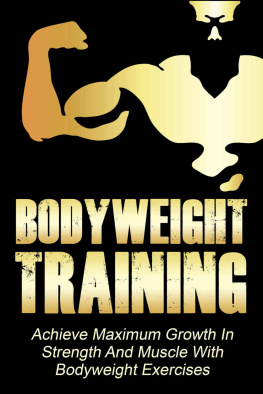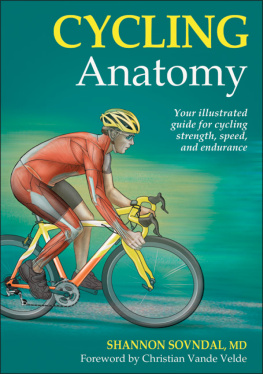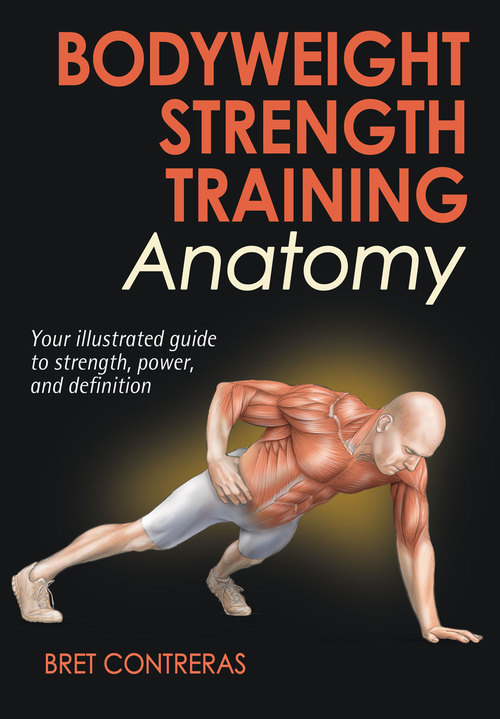
Bodyweight Strength Training Anatomy
Bret Contreras

Human Kinetics
Library of Congress Cataloging-in-Publication Data
Contreras, Bret, 1976
Bodyweight strength training anatomy / Bret Contreras.
pages cm
1. Bodybuilding--Training. 2. Muscle strength. I. Title.
GV546.5.C655 2013
613.7'13--dc23
2013013580
ISBN-10: 1-4504-2929-7 (print)
ISBN-13: 978-1-4504-2929-0 (print)
Copyright 2014 by Bret Contreras
All rights reserved. Except for use in a review, the reproduction or utilization of this work in any form or by any electronic, mechanical, or other means, now known or hereafter invented, including xerography, photocopying, and recording, and in any information storage and retrieval system, is forbidden without the written permission of the publisher.
This publication is written and published to provide accurate and authoritative information relevant to the subject matter presented. It is published and sold with the understanding that the author and publisher are not engaged in rendering legal, medical, or other professional services by reason of their authorship or publication of this work. If medical or other expert assistance is required, the services of a competent professional person should be sought.
Acquisitions Editor: Tom Heine
Developmental Editor: Cynthia McEntire
Assistant Editor: Elizabeth Evans
Copyeditor: Annette Pierce
Graphic Designer: Fred Starbird
Graphic Artist: Kim McFarland
Cover Designer: Keith Blomberg
Photographer (for cover and interior illustration references): Neil Bernstein
Visual Production Assistant: Joyce Brumfield
Art Manager: Kelly Hendren
Associate Art Manager: Alan L. Wilborn
Illustrator (cover and interior): Jen Gibas
Printer: United Graphics
Human Kinetics books are available at special discounts for bulk purchase. Special editions or book excerpts can also be created to specification. For details, contact the Special Sales Manager at Human Kinetics.
Printed in the United States of America
10 9 8 7 6 5 4 3 2 1
The paper in this book is certified under a sustainable forestry program.
Human Kinetics
Website: www.HumanKinetics.com
United States: Human Kinetics
P.O. Box 5076
Champaign, IL 61825-5076
800-747-4457
e-mail: humank@hkusa.com
Canada: Human Kinetics
475 Devonshire Road Unit 100
Windsor, ON N8Y 2L5
800-465-7301 (in Canada only)
e-mail: info@hkcanada.com
Europe: Human Kinetics
107 Bradford Road
Stanningley
Leeds LS28 6AT, United Kingdom
+44 (0) 113 255 5665
e-mail: hk@hkeurope.com
Australia: Human Kinetics
57A Price Avenue
Lower Mitcham, South Australia 5062
08 8372 0999
e-mail: info@hkaustralia.com
New Zealand: Human Kinetics
P.O. Box 80
Torrens Park, South Australia 5062
0800 222 062
e-mail: info@hknewzealand.com
E5716
Contents
Preface
Because youre reading this book, I think its safe to say that youre interested in learning how to build strength and fitness through bodyweight training. If so, thats great! Youve come to the right place.
Over the past 20 years, Ive never taken more than a few days off from strength training. Although Ive trained in hundreds of amazing gyms, studios, and facilities, on many occasions Ive had to make do with what I had in my house, apartment, or hotel room. When I first started training with weights at the age of 15, I didnt know what I was doing. I remember feeling awkward, uncomfortable, and uncoordinated with many of the exercises. As a matter of fact, I avoided most multijoint exercises because I didnt feel them working the way I felt isolation exercises working. Looking back, I realize that I was a skinny weakling who possessed extremely inferior levels of core stability, single-leg stability, and motor control. I simply wandered around aimlessly without a plan, moving randomly from one exercise to another.
At first, I couldnt perform push-ups so I didnt bother trying them. In fact, I couldnt perform a chin-up, dip, or inverted row, either. I suspect that had I attempted a bodyweight full squat my back would have rounded and my knees would have caved in (the melting-candle syndrome) because my glutes were incredibly weak and I had no knowledge of proper form. It took me five years to be able to perform a bodyweight chin-up and dip.
Ive spent the past 20 years learning as much as I can possibly learn about the human body as it pertains to strength and conditioning. Had I known then what I know now, I could have accelerated my results by several years by sticking to a proper exercise progression system and program template. I venture to guess that I could have been performing chin-ups and dips within my first year of training had I possessed a sound understanding of form, exercise progression, and program design. I want to go back in time to help my younger, confused (but determined) self. I wish that the current me could mentor the former me and teach him the ropes.
Flash forward 20 years. I feel great, my joint health is outstanding, my strength levels are highly advanced, and my muscle control is superior. Im now able to achieve an amazing workout using just my own body weight and simple household furniture. I lean my back on couches in order to work my glutes. I hang on to tables and chairs to work my back and legs. And all I need is the ground to work my chest, shoulders, legs, and core.
I believe that all strength trainees should master their own body weight as a form of resistance before moving on to free weights and other training systems. Bodyweight exercises lay the foundation for future training success, and correct performance requires a precise blend of mobility, stability, and motor control. As you make progress and gain strength, it is possible to continue to push yourself through bodyweight training so you continue to challenge the muscles and increase your athleticism. But you need to learn the exercises and have a road map to help get you there.
Bodyweight Strength Training Anatomy was written for several categories of people:
- Beginners who need to learn the basics of bodyweight training. Everyone knows about push-ups and squats, but not everyone knows about hip thrusts, RKC planks, and inverted rows. These exercises should be staples of every strength enthusiasts routine.
- Folks who want to be in great shape but dont like attending gyms. If this describes you, then rest assured that you will always be able to receive an amazing workout no matter where you are.
- Fit exercisers who do a lot of traveling. Sure its nice to have access to hundreds of thousands of dollars of strength training equipment, but if youre frequently on the road then you know that this option is not always feasible.
- All strength training enthusiasts. Regardless of whether youre a weekend warrior, an athlete, a lifter, a coach, a trainer, or a therapist, if your line of work involves fitness then you need to understand bodyweight strength training. Strength training enthusiasts may have specific fitness goals, such as improving functional strength, gaining muscle, losing fat, or improving posture, and bodyweight training will help each of these people achieve those goals.
Here is how I lay out the book. Chapter 1 introduces bodyweight training. Chapters 2 through 9 discuss functional anatomy and its role in sports and aesthetics and lay out the best bodyweight exercises for these muscle groups: arms, neck and shoulders, chest, core, back, thighs, glutes, and calves. In chapter 10, I go over whole-body exercises and explain their purpose. Finally, in chapter 11, the most important chapter of all, I teach you the basics of program design and provide several sample templates for you to follow.
Next page
